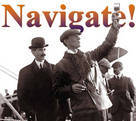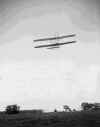|

 Up
Up 
 A Practical
A Practical
Flying
Machine

(You are here.)
 Down
Down




  Need
to Need
to
find your
bearings?
Try
these
navigation aids:
If
this is your first
visit, please stop by:
Something
to share?
Please:



|
|
Available in Française, Español, Português, Deutsch, Россию,
中文,
日本, and others.
 he Wrights began to
rebuild their aircraft in May of 1905, salvaging the engine, propellers, and hardware. The
new Flyer III was designed to overcome the problems they had encountered in 1904. Both the
elevator and the rudder were larger, giving the airplane more "authority" in
pitch and yaw control. The brothers had also encountered problems with "side
slips" -- the airplane tended to slide sideways in the air during a turn -- so they
installed semi-circular "blinkers" between the elevator surfaces to keep
the airplane flying forward. And they had noticed the propellers tended to twist and
flatten while they were spinning, reducing thrust. The prevent this, they attached tabs
they called "little jokers" to the trailing edges of the blades. he Wrights began to
rebuild their aircraft in May of 1905, salvaging the engine, propellers, and hardware. The
new Flyer III was designed to overcome the problems they had encountered in 1904. Both the
elevator and the rudder were larger, giving the airplane more "authority" in
pitch and yaw control. The brothers had also encountered problems with "side
slips" -- the airplane tended to slide sideways in the air during a turn -- so they
installed semi-circular "blinkers" between the elevator surfaces to keep
the airplane flying forward. And they had noticed the propellers tended to twist and
flatten while they were spinning, reducing thrust. The prevent this, they attached tabs
they called "little jokers" to the trailing edges of the blades.
They were back into the air again in late June, but still the Flyer was
not right. They made eight flights in the new Flyer 3, the longest less than 20 seconds,
and every flight ending with damage to the aircraft. On July 14, Orville smashed into the
ground at over 30 miles per hour, crumpling the front elevator. The Flyer
III bounced three
times, throwing Orville out through the top wing. Wilbur found him dazed and confused,
lying on what was left of the elevator. Orville was still in one piece, but this
potentially fatal crash forced the brothers to take a long, hard look at their aircraft
design. There was something woefully wrong with the elevator.
Its position, the brothers concluded, was much to close to the wings to
provide effective control. It needed to be placed further out to give it more leverage.
They rebuilt the Flyer again, enlarging the elevator once more and moving it from 7-1/2
feet to nearly 12 feet out from the wings. They also extended the rudder and made new
"bent-end" propellers. The bent ends served the same function as the little
jokers -- they prevented the spinning propellers from flattening and losing thrust.
Orville and Wilbur began to fly again in late August, and it was
immediately apparent that the new, improved Flyer 3 was truly airworthy. In less that a
week, they were flying multiple circuits around the prairie, landing without a single
serious accident. On September 26, Wilbur flew for over 18 minutes, running the gas tank
dry for the first time. Orville broke the half-hour mark on October 3.
Word began to spread that something extraordinary was going on at Huffman
Prairie and people began to come to watch. Far from discouraging spectators,
the Wrights invited people they thought would make credible witnesses. They
sent out about 30 invitations to see the flights on October 4, and
eyewitnesses have estimated that several hundred showed up, including those
aboard the Interurban trains the stopped to watch the spectacle.
On October 5 another small crowd of people -- including Torrence Huffman and Dave Beard
-- gathered to watch Wilbur and Orville fly. The first flight in the morning was short,
just 40 seconds -- the Flyer III rose gently into the air, made a 180-degree turn, and
glided back to a safe landing. But in the afternoon, Wilbur flew 30 circuits,
remaining in the air for 39 minutes, covering over 24 miles, and landing only when he was
out of gas. Not only had he made the longest flight in history, this one flight racked up
more air time that all the flights of 1903 and 1904 put together.
The 1905 Wright Flyer III was the marvelous result of careful, painstaking
engineering. Built up in tiny increments, beginning with the Wright's kite
experiments of 1899, it was the first flying machine capable of taking off and flying
through the air under its own power; rising, descending, and turning in any direction
under the control of a pilot; and landing -- without crashing -- in any suitable location.
In short, the Flyer 3 was the world's first practical airplane.
Once again, the newspapers began to take notice. Stories appeared in the
Dayton Journal, the Dayton Daily News, the the Cincinnati Post. Knowing
that premature exposure could place their patent rights -- and their financial future --
in jeopardy, the Wrights decided to halt their test flights until they had a secure patent
and buyer for their aircraft. The triumphant 1905 flights would be the last they would
make for nearly 3 years. Eyewitness Report
- Personal Recollections of the Wrights
-- Just after the death of Wilbur Wright in 1912, William Werthner, who
had helped the brothers from time to time at Huffman Prairie,
remembered the day when six long years of work finally paid off.
|
Click on a photo or
drawing to
enlarge it.


To give the Flyer better control, the Wrights
enlarged both the rudder and the elevator and extended them out from the
wings, as you can see by comparing these drawings.

The 1905 Wright Flyer 3 over
Huffman Prairie on September 29, when it made 14 rounds of the field and
ran the gasoline tank dry for the second time.

A close-up of the Flyer 3 in flight on October 4,
when it flew for 34 minutes before a crowd of invited (and uninvited)
guests.

Another view of the October 4, 1905 flight. The Wrights
had just fit a new gas tank to the Flyer to enable it to fly for longer
periods of time. The next day, they flew 24 miles in 39 minutes.

The restored 1905 Wright Flyer 3 rests in Carillon Park
in Dayton, Ohio. If you'd like to take a virtual walk around the world's
first practical flying machine, click
HERE.
|